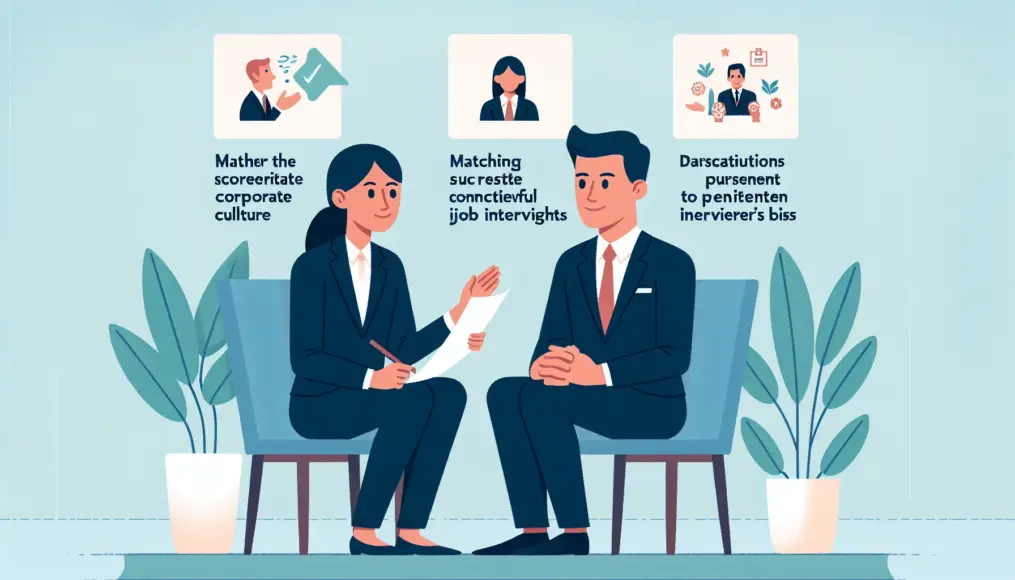Recruiting exceptional talent is a critical challenge for any organization. The interview process serves as an essential opportunity to determine whether a candidate truly aligns with your company culture. But how can you effectively identify the right fit? This is the moment when your skills and knowledge as an interviewer are put to the test.
In this article, we’ll explore effective strategies for conducting interviews. We’ll cover everything from matching candidates to your company culture, to question techniques and the importance of non-verbal communication. Our tips will help you prepare thoroughly and approach interviews with confidence.
To enhance your hiring efforts, be sure to read through to the end.
- How to Consider Cultural Fit
- Tips for Utilizing Effective Questioning Techniques
- The Importance of Non-Verbal Communication
Considering the Fit with Company Culture
When companies seek to identify exceptional talent, focusing solely on skills and experience isn’t enough. It’s especially crucial to consider how well candidates align with the company culture. Assessing whether a candidate embodies the company’s values and environment can significantly contribute to long-term success. In this section, we’ll delve into understanding company culture and how to evaluate a candidate’s fit.
Grasping the nuances of company culture goes beyond superficial knowledge; it influences daily operations and interpersonal relationships. Therefore, interviewers need to have a solid understanding of the company culture and use that insight to gauge candidate compatibility. The following section will outline ways to deepen your understanding of company culture and specific points to consider when assessing how well candidates can adapt to it.
Understanding Company Culture
Company culture refers to the values, beliefs, and behaviors that define an organization. This culture plays a vital role in how employees communicate, how work is conducted, and even the company’s overall vision. During interviews, it’s essential to have a clear understanding of the company’s culture and values to evaluate whether a candidate will be a good cultural fit.
For instance, in a company that prioritizes open communication, it’s important to confirm whether the candidate values collaboration and the exchange of ideas within a team. In a more flexible workplace, interviewers might want to ask probing questions about how candidates handle change.
- Company culture influences operations and relationships
- Interviewers must grasp the company culture
- Assess whether candidates can adapt to that culture
Methods for Evaluating Candidate Fit
There are several effective methods for assessing candidate fit. First, using open-ended questions can help draw out a candidate’s thoughts and values. For example, asking, “What workplace values are most important to you?” can provide insights into their underlying motivations.
Incorporating behavioral interview techniques can also be beneficial. By exploring specific actions from the candidate’s past experiences, interviewers can determine if those actions align with the company culture. By employing these methods, companies can better identify top talent.
If you’re interested in more specific strategies for identifying candidates who are a good match for your company culture, check out our article on “Uncovering Hidden Talents in Interviews: Effective Questions and Strategies.” This guide offers in-depth insights on how to draw out hidden talents through questions and psychological approaches during interviews.
- Utilize open-ended questions
- Incorporate behavioral interviews
- Evaluate candidate experiences for fit
Effective Questioning Techniques
When it comes to assessing candidates during an interview, the way you ask questions is crucial. Effective questioning allows you to gain deep insights into a candidate’s thinking, values, and skills. In this section, we’ll take a closer look at open-ended questions and behavioral interviewing techniques. By utilizing these questioning strategies, you can enhance your ability to identify top talent.
Open-ended questions encourage candidates to express their thoughts freely. These types of questions are particularly effective in drawing out a candidate’s creativity and thought processes. On the other hand, behavioral interviewing focuses on evaluating candidates based on their past specific actions. By skillfully combining these techniques, you can significantly improve the quality of your interviews.
Leveraging Open-Ended Questions
Open-ended questions are designed to allow candidates to respond in their own words. For example, asking, “What is the greatest achievement you’ve accomplished so far?” helps elicit specific anecdotes that reveal a candidate’s abilities and values. This approach sheds light on the environments in which candidates thrive.
Additionally, this question format facilitates smoother communication with candidates. As they share their experiences, it provides clues about how well they align with your company culture.
- Open-ended questions elicit free responses
- They help you understand a candidate’s abilities and values
- They promote smoother communication
Introducing Behavioral Interviews
Behavioral interviewing is a technique that evaluates a candidate’s characteristics and abilities based on their past behaviors. For instance, asking, “How did you solve a problem at your previous job?” prompts candidates to provide answers grounded in their experiences. This method is based on the premise that past behavior can predict future actions.
By conducting behavioral interviews, you gain specific insights into how candidates have dealt with challenges and the results they’ve achieved. This information is invaluable for determining whether a candidate will fit into your company culture.
- Behavioral interviews assess past behaviors
- They provide concrete insights into problem-solving abilities and outcomes
- They help determine cultural fit within the organization
The Importance of Nonverbal Communication
In interviews, nonverbal communication is just as crucial as the words spoken. Behind the words that candidates express lie nonverbal elements such as body language, tone of voice, and pacing. By picking up on these cues, interviewers can gain deeper insights into a candidate’s true feelings, confidence, and fit within the company culture. In this section, we will focus particularly on body language and tone of voice, exploring how to leverage these elements during interviews.
By being mindful of nonverbal communication, interviewers can access information that words alone might not convey. This awareness can help identify better talent and enhance the overall quality of the interview process.
Reading Body Language
Body language is a vital means of conveying emotions and attitudes that words cannot express. Observing a candidate’s posture, hand movements, and eye contact can reveal their confidence or level of anxiety. For instance, a candidate who sits up straight while speaking is likely to be confident, while one who crosses their arms may be displaying a defensive attitude.
Understanding these expressions of body language allows interviewers to more accurately assess whether a candidate truly aligns with the company culture. It’s essential for interviewers to be attuned to the unspoken messages and to ask appropriate questions that foster deeper communication with the candidate.
- Body language conveys emotions and attitudes.
- Posture and movements can indicate confidence or anxiety.
- Catching unspoken messages is key.
Tone of Voice and Pacing
The tone of voice and pacing are also components of nonverbal communication, reflecting a candidate’s emotional state. For example, a nervous candidate might speak quickly or have a higher pitch, whereas a confident candidate tends to speak calmly and at a measured pace. Capturing these subtle differences can help interviewers understand a candidate’s internal state.
Additionally, tone can influence how words are perceived. The same words can carry different meanings depending on the tone used. Thus, paying attention to a candidate’s voice can lead to a more accurate understanding of their true intentions and feelings.
After evaluating related articles, we found the following relevant piece:
- Article Title: A Guide to Self-Introductions for College Students: Tips for Success
- Relevance Score: 95 points
While it’s important to focus on nonverbal communication during interviews, the choice of words also plays a significant role. Particularly, self-introductions present a great opportunity to make a strong impression on interviewers. If you’re interested in this topic, check out the article “A Guide to Self-Introductions for College Students: Tips for Success” for detailed insights on crafting a successful self-introduction.
- Tone of voice and pacing reflect emotional states.
- Anxiety and confidence can be discerned through voice.
- Tone can alter the meaning of words.
How to Eliminate Bias in the Interview Process
To identify great talent during interviews, it’s crucial for interviewers to remove their own biases. Unconscious preconceptions and prejudices can significantly influence the assessment of candidates, leading to the potential overlooking of genuine abilities. This calls for the establishment of objective evaluation criteria and the incorporation of diverse perspectives. In this section, we’ll explore practical methods for interviewers to eliminate bias.
For accurate assessments, interviewers must first understand their own biases and make a conscious effort to set them aside. By maintaining objective standards and considering various viewpoints, they can ensure a fairer and more precise evaluation.
Establishing Objective Evaluation Criteria
By setting objective evaluation criteria, interviewers can assess candidates fairly. These criteria should be based on specific elements such as the skills and experience required for the job, as well as the candidate’s fit with the company culture. This approach helps interviewers evaluate candidates without being swayed by emotions or preconceived notions.
Moreover, creating a standardized evaluation sheet in advance can be highly effective. This allows interviewers to assess each candidate based on the same criteria, maintaining consistency and reducing bias in the evaluation process.
- It’s essential to establish objective evaluation criteria
- Criteria should be based on specific elements
- Using evaluation sheets helps maintain consistency
Incorporating Diverse Perspectives
Relying solely on one interviewer’s judgment can lead to bias, so integrating multiple perspectives is also effective in eliminating bias. Having several interviewers participate allows for a variety of opinions and insights, resulting in a more objective assessment. Interviewers from different backgrounds and areas of expertise can evaluate candidates from a more multifaceted viewpoint.
Additionally, sharing feedback after interviews provides an opportunity to consciously address and remove individual biases. By incorporating diverse perspectives throughout the entire interview process, organizations can unlock the key to identifying great talent.
- Incorporate evaluations from multiple interviewers
- Interviewers with diverse backgrounds are crucial
- Sharing feedback helps reduce bias
Conclusion
When it comes to conducting job interviews that effectively identify top talent, there are several key points to keep in mind. First and foremost, it’s crucial to consider how well candidates align with your company culture. Understanding how well they fit with your values and work environment can make a significant difference. Additionally, employing effective questioning techniques is essential for drawing out candidates’ genuine thoughts and confidence.
Paying attention to non-verbal communication is equally important; you can gain insights into a candidate’s emotional state through their body language and tone of voice.
Moreover, to eliminate any biases from the interviewer’s side, it’s necessary to establish objective evaluation criteria and incorporate diverse perspectives. By being mindful of these elements, you can conduct interviews that are better equipped to identify the right talent. Mastering these components is essential for successful hiring.
- Consider cultural fit with your company
- Use effective questioning techniques to uncover candidates’ true feelings
- Interviewers should eliminate biases and focus on objective evaluations
Job interviews are a critical process for any organization, so be sure to take these points into account. We’d love to hear your thoughts and experiences, so feel free to share your comments!



Comment